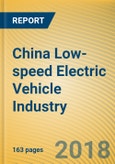Benefited from the economic growth in urban-rural fringe zones and rural areas as well as the growing mobility demand, the low-speed electric vehicle sales have been on a steady rise over the past years, up 41.6% from 1.232 million units in 2016 to 1.744 million units in 2017. However, the LSEV industry will still face relatively great policy risk, especially Standardization Administration of the PRC will formulate more stringent LSEV standard, which will be formally issued before 2019.
In addition, State Council has defined the work idea of “upgrading a batch, standardizing a batch and eliminating a batch” (“three batches”: upgrading qualified low speed electric vehicle manufacturers to conventional battery electric passenger vehicle companies; standardizing technical standards, market entry, regulatory system and administration for low speed electric vehicles; eliminating unqualified companies and their products), so the industry reshuffle is inevitable. Also, it will be squeezed by mini electric vehicle makers with production licenses, but of which its competitiveness is slightly down along with sliding national and local subsidy. Therefore, the LSEV market size will see a slowdown in growth rate and the output of LSEVs will be about 3.37 million units in China in 2022. Once the standard took into force, the data would shrink to 700-800 thousand units quickly.
Regarding competition pattern, BYVIN, YOGOMO, and Shifeng Group are the top3 players in the LSEV market. BYVIN, as a market bellwether, is the first enterprise with annual output of more than 202,000 units by adopting multi-brand (including LEVDEO) strategy to expand its market share in all market segments; YOGOMO, the largest LSEV enterprise in Hebei province, boasts four brands (YOGOMO, CYAHOR, YGM, and LaVie) and produces about 120,000 units annually; Shifeng Group, majored in agricultural three wheeler, also sets foot in LSEV field with capacity of 200,000 units, and ranks third with sales volume of 110,000 units in 2017.
Along with being gradually clear of LSEV industry standard and policies, some companies, such as GreenWheel, Henan SD, YOGOMO and Lichi jumped out of LSEV field and entered micro high-speed electric vehicle industry and have obtained the license for the production of battery electric sedans or special vehicles. Meanwhile, there are also some makers slowing down the investment for LSEV, like YOGOMO’s 150,000 unit/a LSEV projects in Wuxi and Baoya’s 500,000 unit/a NEV base in Xiangyang city do not realize operation as planned.
China Low-speed Electric Vehicle (LSEV) Industry Report, 2018-2022 highlights the following:
- Overview of the LSEV industry in China (definition, classification, development trends, etc.);
- LSEV market segments including electric bicycle, electric tricycle, LSEV, and all-terrain vehicle (industry standards, relevant policies, market size, competitive landscape, development trends, etc.);
- Market for relevant key parts (battery, motor, motor controller, and BMS) (competitive landscape, manufacturers, etc.);
- 17 major manufacturers (Yadea, AIMA, SUNRA, BYVIN, Jinpeng, Dojo, YOGOMO, BYVIN, Shifeng Group, Tokng, Fulu Vehicle, LEVDEO, KNDI, Lichi, Rainchst, DURABLEV and Baoya) (profile, financial position, leading products, R&D, distribution of production bases, technical features, etc.)
*The Chinese Version of this Report is Available on Request.
This product will be delivered within 3-5 business days.
Table of Contents
Companies Mentioned
- AIMA
- Yadea
- BYVIN
- SUNRA
- Jinpeng
- YOGOMO
- Shifeng Group
- Tokng
- Fulu Vehicle
- Dojo
- Baoya
- LEVDEO
- Lichi
- Rainchst
- Hebei Yudea New Energy Technology Group Co., Ltd.
- DURABLEV
- Han Tang Electric Vehicle
- Shenzhen Tian-Power Technology Co., Ltd.
- Addenda Technology (Guangzhou) Co., Ltd.
- Shenzhen Guoxin Power Technology Co., Ltd.
- Jiangxi Keran Technology Co., Ltd.
- Hangzhou Gold Electronic Equipment INC., Ltd.
- Changsha Juli Electric Technology Co., Ltd.
- Xi’an Jindee Electrical Technology Co., Ltd.
Methodology

LOADING...








